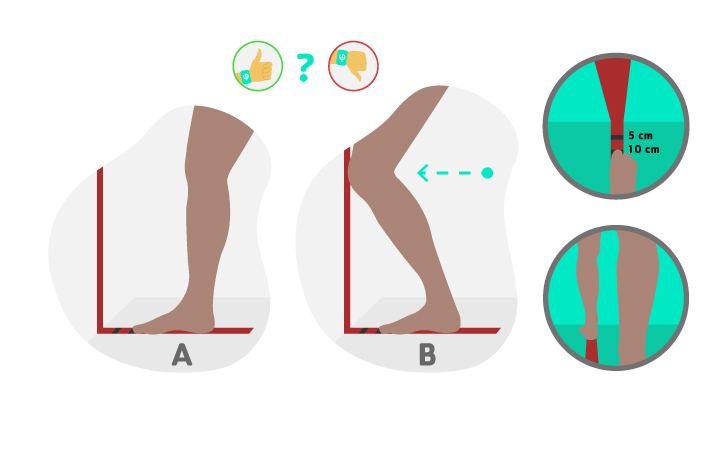
Lunge test (ankle flexibility)
This test is used to assess the degree of ankle flexibility as well as gastrocnemius muscle shortening under load.
- Required materials: A non-slip flat surface, a wall, adhesive tape and a measuring tape
- Procedure: Two adhesive tapes are placed forming a 90º angle between them, one 60 centimeter (cm) long on the length of a wall and another 50 cm long on the length of the floor. Two marks are made on the floor tape at 5 and 10 cm away from the wall. The subject is asked to place their bare foot on the floor line, placing their longest toe (1st or 2nd toe) on the line located 10 cm from the wall (Illustration A). From this position, the subject is asked to bring their knee to the wall (Illustration B) without lifting their heel off the floor. If during the test the subject lifts their heel they should move their foot closer until they can complete the test without lifting it. Both sides should be assessed.
- Assessment: If the subject is able to touch the wall with their knee without lifting their heel off the floor, from the reference position (10 cm), the test is considered normal or negative. On the contrary, if the subject lifts the heel or needs to come closer to the 5 cm mark or even surpass it, it means that there is limitation in the ankle joint movement due to contraction of the gastrocnemius, considering the result of the test as abnormal or positive.
- Remarks: Se considera el valor de 10º de flexión dorsal del tobillo como el valor mínimo aceptable a nivel funcional, siendo lo ideal entre 20-30º. Todo lo que esté por debajo de 10º en rango de movimiento (ROM) puede suponer que el sujeto padezca patolog
Take this test and 139 more in our App